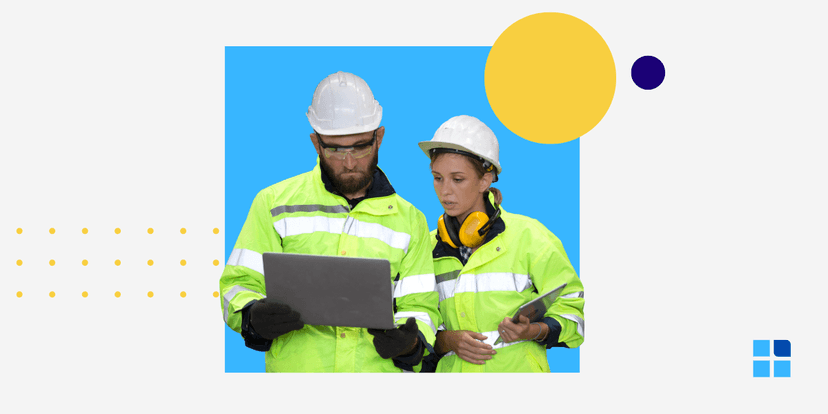Manufacturing environments are dynamic and complex, often involving a variety of machinery, chemicals, and processes that can pose significant risks to worker safety. Understanding common manufacturing hazards is essential for creating a safer workplace and preventing accidents. In this blog post, we will explore the top five common manufacturing hazards, along with practical strategies for mitigating their risks.
Understanding manufacturing hazards
Manufacturing hazards encompass a range of risks that can jeopardize both the safety of your workers and the quality of your products.
The manufacturing industry is inherently prone to various hazards due to the complexity and nature of its operations. These hazards can be broadly categorized into physical, chemical, biological, ergonomic, and psychological risks.
- Physical hazards include machinery-related injuries or exposure to high noise levels.
- Chemical hazards involve handling toxic substances or exposure to harmful fumes.
- Biological hazards may arise from working with contaminated materials.
- Ergonomic hazards stem from repetitive motion or poor workstation design.
- Psychological hazards, such as stress or fatigue, can also affect workers' mental health and productivity.
Recognizing and mitigating these hazards is essential for ensuring a safe working environment, complying with safety regulations, and maintaining high standards of product quality. By understanding these risks, you can implement effective safety measures to protect your workforce and sustain operational efficiency.
Top five common manufacturing hazards and mitigation strategies
Manufacturing environments are constantly bustling with activity and complex machinery. As a result, this presents a variety of hazards that can impact worker safety. Recognizing these workplace hazards is crucial for implementing measures to mitigate risks and protect employees.
Here are the top five common manufacturing hazards along with strategies on how to reduce them:

1. Electrical hazards
Electrical hazards pose significant risks in manufacturing settings, primarily stemming from faulty electrical equipment and improper usage. These hazards can lead to severe injuries or even fatalities if not addressed appropriately.
How to mitigate electrical hazards:
- Regularly inspect and maintain electrical systems and equipment.
- Train employees on safe electrical practices and proper equipment usage.
- Install circuit breakers and ground fault circuit interrupters (GFCIs).
- Use insulated tools and equipment.
- Clearly label electrical panels and circuits.
2. Chemical hazards
The use of hazardous chemicals and materials in manufacturing processes can lead to various health issues. For instance, skin irritation and respiratory problems. Exposure to these chemicals, whether through inhalation, skin contact, or accidental ingestion, requires strict safety measures.
How to mitigate chemical hazards:
- Implement proper storage and labeling of hazardous materials.
- Provide appropriate personal protective equipment (PPE) such as gloves, masks, and goggles.
- Ensure proper ventilation in areas where chemicals are used or stored.
- Conduct regular safety training on chemical handling and emergency procedures.
- Maintain Material Safety Data Sheets (MSDS) readily available for all chemicals.
3. Slips, trips, and falls
Slips, trips, and falls are prevalent safety hazards in manufacturing facilities. In fact, they are often caused by wet or oily surfaces, cluttered walkways, and uneven floors. These incidents can result in injuries ranging from minor bruises to severe fractures.
How to mitigate slips, trips, and falls:
- Maintain clean and unobstructed workspaces.
- Use anti-slip floor treatments and mats.
- Clearly mark hazardous areas with appropriate signage.
- Regularly inspect and repair flooring and walkways.
- Implement a housekeeping protocol to keep areas tidy.
4. Machine guarding hazards
Machine guarding hazards arise when machinery is not properly installed or maintained, leading to potential contact with moving parts. This can result in serious injuries or fatalities.
How to mitigate machine guarding hazards:
- Equip all machinery with appropriate guards and safety devices.
- Conduct regular inspections and maintenance of machinery.
- Train employees on safe operation and the importance of guarding.
- Implement lockout/tagout (LOTO) procedures during maintenance.
- Use safety interlocks that prevent operation when guards are removed.
5. Ergonomic hazards
Ergonomic hazards in manufacturing are often associated with repetitive motions, heavy lifting, and exposure to vibrations or loud noise. These factors can cause long-term musculoskeletal disorders and other health issues.
How to mitigate ergonomic hazards
- Design adjustable workstations to accommodate different worker heights and tasks.
- Train employees on proper lifting techniques and ergonomics.
- Rotate tasks among employees to reduce repetitive strain.
- Implement noise reduction measures and provide hearing protection when necessary.
- Encourage regular breaks to reduce fatigue and discomfort.
The importance of identifying manufacturing hazards
Identifying hazards is essential for ensuring the safety and well-being of workers in the manufacturing industry, maintaining operational efficiency, and complying with regulatory standards. Here are several reasons why it is important to identify and address these potential hazards:

1. Ensuring worker safety
The primary concern in manufacturing environments is the safety of workers. Identifying hazards helps prevent accidents and injuries by addressing potential risks before they lead to incidents. What’s more, ensuring a safe workplace protects employees from harm and fosters a culture of safety awareness.
2. Reducing accident and injury rates
By recognizing and mitigating hazards, you can significantly reduce the occurrence of workplace accidents and injuries. This proactive approach minimizes lost workdays, medical expenses, and compensation claims. Therefore, contributing to overall operational efficiency.
3. Enhancing operational efficiency
Identifying and addressing hazards can lead to smoother operations by preventing disruptions caused by accidents or equipment failures. A safe and hazard-free environment allows workers to perform their tasks more efficiently. This, in turn, leads to increased productivity and reduced downtime.
4. Complying with legal and regulatory standards
As a manufacturer, you are required to adhere to various safety regulations and standards. So, identifying hazards is essential for compliance with these legal requirements. Failure to comply can result in fines, legal action, and damage to your organization's reputation.
5. Protecting company reputation
A strong safety record enhances your company's reputation among employees, customers, and stakeholders. By identifying and addressing hazards, this demonstrates a commitment to safety and ethical business practices, which improves your brand image and trustworthiness.
6. Preventing financial losses
Accidents and injuries can lead to significant financial losses. For example, medical costs, legal fees, and compensation claims. By identifying hazards, you can mitigate these financial risks and allocate resources more effectively to safety initiatives.
7. Fostering a positive work environment
A focus on safety and hazard identification contributes to a positive work environment where your employees feel valued and secure. As a result, this boosts morale, increases job satisfaction, and fosters a sense of ownership and responsibility among workers.
8. Supporting continuous improvement
Regularly identifying and addressing hazards aligns with the principles of continuous improvement. By consistently evaluating and enhancing safety measures, you can create a culture of continuous improvement and development.
Best practices for minimizing hazards in manufacturing workplaces
Prioritizing workplace safety and taking preventative measures to protect workers from accidents, illnesses, or potentially life-changing or fatal injuries is crucial for any manufacturing company.
By implementing comprehensive safety strategies, this not only safeguards employees, but also enhances productivity and operational efficiency. Here are some general best practices for minimizing hazards in the manufacturing industry:
1. Develop a comprehensive occupational safety program
To minimize hazards, it is essential to conduct a thorough risk assessment that identifies potential hazards in the workplace. In other words, clear safety procedures and policies should be established, tailored to meet specific operational needs.
Regular reviews and updates of safety protocols are also necessary to address new risks or changes in operations. Additionally, implementing emergency response plans and conducting regular drills will ensure preparedness for any unforeseen incidents.
2. Provide extensive safety training
All employees should receive comprehensive safety training on essential topics before they start work. For example, the use of machinery, handling hazardous materials, and emergency procedures.
Ongoing training sessions and refresher courses are key to keep employees informed about the latest safety practices and technologies. Utilizing a variety of training methods, including hands-on demonstrations, workshops, and e-learning modules, will help cater to different learning styles and enhance understanding.
3. Foster a culture of safety
Creating a culture of safety involves emphasizing personal responsibility by encouraging employees to report near misses, identify hazards, and halt unsafe work practices immediately. To foster a positive safety environment, you should recognize and reward employees who consistently follow safety protocols or contribute to safety improvements.
Open communication and feedback channels should also be promoted to address safety concerns and suggestions from employees. Management and supervisors must lead by example, prioritizing safety in their actions and decisions.
4. Leverage technology for enhanced safety
Implementing predictive maintenance technologies can help monitor equipment health and predict potential failures. Thereby, reducing the risk of accidents. By utilizing virtual reality (VR) training programs, this can simulate real-world scenarios and enhance workers' ability to respond to emergencies safely.
Wearable technology can also be deployed to monitor workers' health metrics and environmental conditions, providing alerts for unsafe situations. Furthermore, incorporating automation and robotics minimizes human exposure to hazardous tasks or environments.
5. Conduct regular inspections and audits
Regular safety inspections and audits should be scheduled to identify potential hazards and ensure compliance with safety regulations. Engaging third-party safety experts can provide objective assessments and recommendations for improvement. Any identified issues must be addressed promptly, and corrective actions taken should be documented to prevent recurrence.
6. Improve workplace design and ergonomics
Workstations and equipment layouts should be designed to minimize repetitive movements and awkward postures. Thus, reducing the risk of ergonomic injuries. Providing adjustable tools and equipment accommodates workers of different sizes and abilities. Additionally, ensuring proper lighting, ventilation, and noise control is essential to create a safer and more comfortable working environment.
7. Maintain clear signage and labeling
Using clear and standardized signage is critical for indicating hazards, emergency exits, and safety equipment locations. Chemicals and hazardous materials should be labeled with appropriate warning labels and safety data sheets (SDS). In addition, it is important to ensure that all employees are familiar with the meanings of the safety signs and labels used in the workplace.
Conclusion
In conclusion, understanding and addressing the top five common manufacturing hazards is crucial for ensuring a safe and productive work environment. So, as a manufacturing company, you must take immediate steps to identify and assess routine hazards in the workplace and prioritize worker safety.
By recognizing these common safety hazards in manufacturing and implementing effective safety measures, you can reduce the risk of accidents, improve employee morale and productivity, and ensure compliance with safety regulations.
All in all, a proactive approach to safety, including regular maintenance, proper training, and effective emergency response plans, is essential for maintaining a safe working environment in the manufacturing sector. By doing so, you not only protect your workforce, but also foster a culture of safety and responsibility that contributes to long-term success and sustainability.







